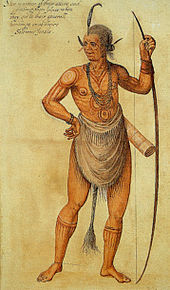Pamlico
The Pamlico , also known as Pomouik , were an Indian tribe whose tribal area was in what is now the state of North Carolina in the southeastern United States . They are considered to be the southernmost tribe in the Algonquin language family .
Tribal area
At the time of their first contact with the Europeans around 1584, the Pamlico lived in villages on the lower reaches of the Pamlico River , a tidal current in North Carolina that is called the Tar River in its upper reaches without tidal range . Their tribal area was to the west of what is now Beaufort County . The climate is humid and subtropical and leads to an annual growth period of around 250 days. In addition to various salt and freshwater fish, there are also oysters , edible clams , sea turtles and American alligators in the rivers and lakes on the coast. The last village was around 1708 on Indian Island in the Pamlico River.
language
The members of this tribe, considered extinct since 1712, spoke the dialect of the North Carolina-Algonquin from the Algonquin language family. In 1701, John Lawson examined their language and vocabulary based on just 37 words. In addition to place and tribal names, fewer than 100 words from other dialects were written down and handed down by English colonists . However, both lists of words are sufficient for an assignment to the Algonquin language family.
Way of life and culture
The Pamlico's life was largely determined by obtaining their daily food, with hunting, fishing and collecting wild herbs for most of the needs, while the rest came from horticulture. Fish was by smoking on from Reet made frames over an open fire or be preserved in the sun. The cultivation of maize , which formed the basis of sedentary life in the villages, was important. In addition, Pamlico u. a. Beans , cucumbers , pumpkins , sunflowers and tobacco. The long annual growing season often allowed two harvests from the same field. Weirs and fishing facilities made of thatch were set up in rivers and estuaries. Another method of fishing was to spear the fish either from a canoe or while wading in shallow water. Little is known about hunting methods, although the hunting of mammals, birds and reptiles must have contributed significantly to the diet. In autumn, various roots, nuts and berries were collected in the woods.
Around ten to thirty houses formed a village, which was sometimes surrounded by wooden palisades . It was usually on a river, lake, or pond. The approximately 11 to 14 meters long houses were rectangular and had rounded roofs made of curved poles. They only had one room and there were raised platforms along the walls for sleeping. Chiefs' houses and temples were considerably larger, but resembled normal houses in shape and construction. The Pamlico were skilled canoeists and made long journeys in their dugout canoes , which could carry up to 20 people and were moved forward by paddling or pinning.
history
First contacts with Europeans occurred after the founding of the Roanoke colony on August 17, 1585. She was the first colony of the British in North America, but had a few years to be abandoned later and carries since then the name Lost Colony (dt. Lost Colony). It was not until 120 years later that the English made a new but successful attempt to establish a colony on the North Carolina coast. As a result, European diseases came to the Indians, against which they had no powers of resistance. From 1696 there is a report of a great mortality in the villages of the Pamlico. By 1709 the population had shrunk to such an extent that only 40–50 tribesmen lived in a single small village on an island in the Pamlico River.
In the Tuscarora War (1711-1713) Tuscarora and allied North Carolina Algonquians, including warriors of the Pamlico, fought against the English colonists. In 1712 the Indians were beaten and more than 300 of them were killed. Over 100 Indians, mostly women and children, were captured and sold into slavery . There is no reliable information about their descendants, so the Pamlico have since been considered extinct.
See also
List of North American Indian tribes
literature
- Bruce G. Trigger (Ed.): Handbook of North American Indians . Vol. 15: Northeast. Smithsonian Institution Press, Washington DC 1978. ISBN 0-16004-575-4
- Wilcomb E. Washburn (Ed.): Handbook of North American Indians . Vol. 4: History of Indian-White Relations. Smithsonian Institution Press, Washington DC 1988. ISBN 0-16004-583-5
- Alvin M. Josephy Jr.: 500 Nations. Frederking & Thaler GmbH, Munich 1996. ISBN 3-89405-356-9
Web links
Individual evidence
- ↑ a b Bruce G. Trigger (Ed.): Handbook of North American Indians. Vol. 15. Northeast. Christian Feest: North Carolina Algonquians , 272.
- ↑ Bruce G. Trigger (Ed.): Handbook of North American Indians. Vol. 15. Northeast. Christian Feest: North Carolina Algonquians , 271.
- ↑ a b Bruce G. Trigger (Ed.): Handbook of North American Indians. Vol. 15. Northeast. Christian Feest: North Carolina Algonquians , 273.
- ↑ a b Bruce G. Trigger (Ed.): Handbook of North American Indians. Vol. 15. Northeast. Christian F. Feest : North Carolina Algonquians , 279-280.



